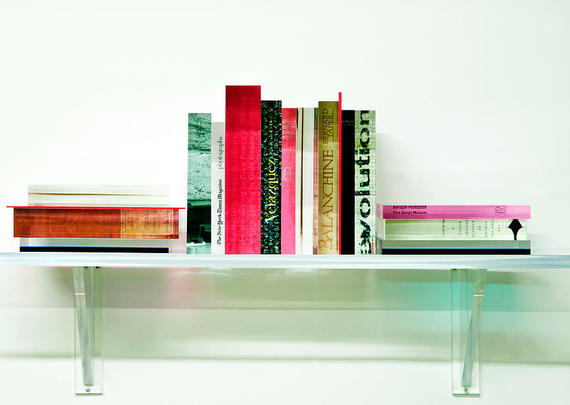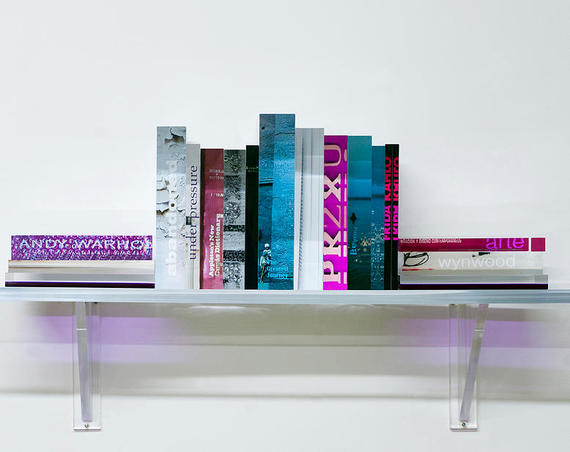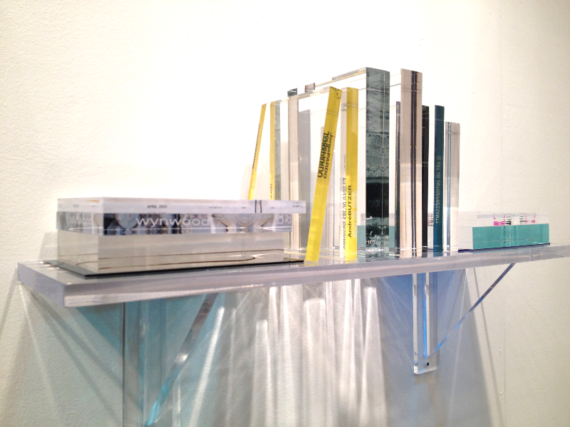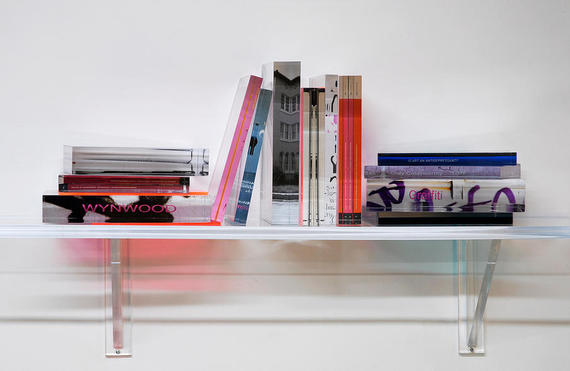"We do not retain in memory complete books identical to the books remembered by everyone else, but rather fragments surviving from partial readings, frequently fused together and further recast by our private fantasies...The title of the work, its place in the collective library, the nature of the person who tells us about it, among many other instances, offer alternatives to the book itself that allow us to talk about ourselves." ― Pierre Bayard

Pancho Luna: Evolution (2015). All images courtesy of Timothy Yarger Fine Arts
Books have always been symbols as much as objects -- perhaps even more so. When they were precious and rare, owning them was a sign of power and wealth. When they became widely disseminated, they (and the access to knowledge they represented) were seen as a threat to those social structures. In more modern times, the book has become a bit of both. A collection, a library, or just what's on your shelves or coffee table now says as much about you as the clothes you wear, and people curate their bibliographic displays as much for public appreciation as for personal expression. Moreover, every book collector has their own unique system for organizing their volumes -- by author, subject, binding, jacket, language, date, size, circumstance, and intuition. Connections between and among them are organic, malleable, arbitrary, and their jostling itself can yield unexpected poetry.

Pancho Luna: Rojo RTK (2015).
Artist Pancho Luna remembers his grandmother's library as an eclectic and rather magical place. It contained volumes of volumes in several different languages, which didn't matter all that much since he started exploring them long before he could read anyway. It turns out there's more than one way to read a book, though, and Luna became enamored of them all -- as pure color, shape, smell, texture, typeface; as repositories of photographs, illustrations, reproductions; and ultimately as sites of experience and triggers of memory -- in short, as both symbols and objects. And it is precisely this multifaceted power to impart knowledge by means other than words on pages which Luna explores in his luminous, alluring, and deceptively simple sculptural works in which recreations of curated bookshelves are rendered in transparent Lucite to powerful, nuanced effect.

Pancho Luna: Beyond Words (2015).
Recreating the esoteric quality of his experiences in those early heady days alone in the family library, Luna engineers quasi-architectural arrangements in which sequences of individually fabricated "books" are placed as carefully as still lifes. Much like those volumes he could not yet read, the seductive appeal of these sculptures is, at least at first, almost entirely aesthetic. The clear, chromatically lined blocks are stacked, aligned, and tilted, setting slivers of fine lines and bright colors in staccato rhythms that flicker and change as the viewer moves across and around, peers inside and pulls away again. Their capturing and refracting of ambient light in blended, geometrical abstraction recalls the materialism of Light & Space artists like Vasa or Larry Bell. And after all, he's a sculptor, not a writer.

Pancho Luna: El Libro de la Ilusiones (2015).
And yet, Luna is no pure abstractionist. Fundamentally, he is a storyteller interested in communicating fresh ideas about art history, global political and social issues, technology, science, architecture, music, religion, and cultural identity. Thus each bookshelf must also be understood as a narrative contained within itself, one that unfolds not only through Luna's deft and refined beckoning formalism, but also through evocative meanings generated by choices that are in no way accidental. Though these books cannot be opened, they can very much still be read.

Pancho Luna: Graffiti (2015).
PANCHO LUNA: New Work opens Saturday, October 24, at Timothy Yarger Fine Arts in Beverly Hills, and remains on view through January.
Our 2024 Coverage Needs You
It's Another Trump-Biden Showdown — And We Need Your Help
The Future Of Democracy Is At Stake
Our 2024 Coverage Needs You
Your Loyalty Means The World To Us
As Americans head to the polls in 2024, the very future of our country is at stake. At HuffPost, we believe that a free press is critical to creating well-informed voters. That's why our journalism is free for everyone, even though other newsrooms retreat behind expensive paywalls.
Our journalists will continue to cover the twists and turns during this historic presidential election. With your help, we'll bring you hard-hitting investigations, well-researched analysis and timely takes you can't find elsewhere. Reporting in this current political climate is a responsibility we do not take lightly, and we thank you for your support.
Contribute as little as $2 to keep our news free for all.
Can't afford to donate? Support HuffPost by creating a free account and log in while you read.
The 2024 election is heating up, and women's rights, health care, voting rights, and the very future of democracy are all at stake. Donald Trump will face Joe Biden in the most consequential vote of our time. And HuffPost will be there, covering every twist and turn. America's future hangs in the balance. Would you consider contributing to support our journalism and keep it free for all during this critical season?
HuffPost believes news should be accessible to everyone, regardless of their ability to pay for it. We rely on readers like you to help fund our work. Any contribution you can make — even as little as $2 — goes directly toward supporting the impactful journalism that we will continue to produce this year. Thank you for being part of our story.
Can't afford to donate? Support HuffPost by creating a free account and log in while you read.
It's official: Donald Trump will face Joe Biden this fall in the presidential election. As we face the most consequential presidential election of our time, HuffPost is committed to bringing you up-to-date, accurate news about the 2024 race. While other outlets have retreated behind paywalls, you can trust our news will stay free.
But we can't do it without your help. Reader funding is one of the key ways we support our newsroom. Would you consider making a donation to help fund our news during this critical time? Your contributions are vital to supporting a free press.
Contribute as little as $2 to keep our journalism free and accessible to all.
Can't afford to donate? Support HuffPost by creating a free account and log in while you read.
As Americans head to the polls in 2024, the very future of our country is at stake. At HuffPost, we believe that a free press is critical to creating well-informed voters. That's why our journalism is free for everyone, even though other newsrooms retreat behind expensive paywalls.
Our journalists will continue to cover the twists and turns during this historic presidential election. With your help, we'll bring you hard-hitting investigations, well-researched analysis and timely takes you can't find elsewhere. Reporting in this current political climate is a responsibility we do not take lightly, and we thank you for your support.
Contribute as little as $2 to keep our news free for all.
Can't afford to donate? Support HuffPost by creating a free account and log in while you read.
Dear HuffPost Reader
Thank you for your past contribution to HuffPost. We are sincerely grateful for readers like you who help us ensure that we can keep our journalism free for everyone.
The stakes are high this year, and our 2024 coverage could use continued support. Would you consider becoming a regular HuffPost contributor?
Dear HuffPost Reader
Thank you for your past contribution to HuffPost. We are sincerely grateful for readers like you who help us ensure that we can keep our journalism free for everyone.
The stakes are high this year, and our 2024 coverage could use continued support. If circumstances have changed since you last contributed, we hope you'll consider contributing to HuffPost once more.
Already contributed? Log in to hide these messages.





